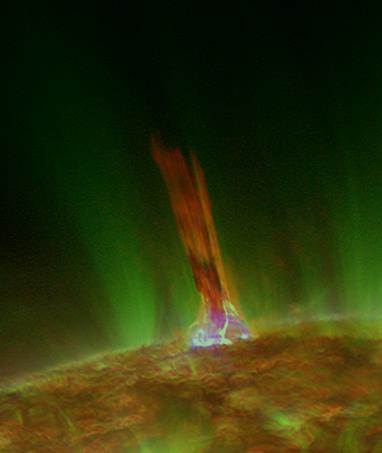During the noon hours of 30 January 2015, a coronal jet was visible near the Sun's east limb. Coronal jets are rather narrow ("squeezed") ejections of solar plasma that result from magnetic reconnection between some emerging flux and pre-existing "open" field structures. The reconnection results in jets that emit material up into the higher solar atmosphere and even into space if the eruption is strong enough.The precise mechanism(s) behind the acceleration and squeezing of the jet are not known yet in full detail. See the movie of this impressive event.

The 30 January jet was visible in EUV from about 12:55 till 14:00UT. It did not leave an obvious x-ray signature, the x-ray flux being mostly influenced by the solar flare activity from active regions NOAA 2268 and 2277. Indeed, the latter produced a short-duration M2 flare peaking at 12:16UT, while the enhanced flux around 12:56UT was produced by activity in NOAA 2268. The slow x-ray evolution of the latter event was not even classified as a flare.

The jet consisted of relatively "cool" material. This can be seen in the comparison images underneath, where the jet becomes "darker" and less visible as the temperature in which the EUV filter observes, increases. The jet was also visible in H-alpha, a filter providing views of the lower solar atmosphere at even lower temperatures (about 10.000 degrees).

What seems to have happened in this case is that a small filament became unstable and, while erupting, got in contact with the "leg" of a low-lying coronal loop. There, the reconnection took place and the material was ejected along the open field lines into space. The point of reconnection and the jet itself seem to be somewhat off-set, hence the name lambda jet (the more symmetrical case is called "Eiffel tower jet"). With some imagination, the greek letter can indeed be seen in the loops and jet. Some further analysis may be required to have a final answer (line-of-sight effects,...). The imagery underneath is a composition of EUV images from AIA 304, 171 and 094 filters.

A rudimentary evaluation of the AIA 304 imagery seems to indicate that the speed of the jet was about 280-410 km/s. This is quite typical for this kind of jets, and it is high enough to allow part of the ejected material to escape into space. This can be seen in images from SOHO's coronagraphs, though the jet quickly becomes diffuse and difficult to trace, which also hampers accurate speed measurements. The rest of the material can be seen falling back along the magnetic field lines towards the solar surface (EUV imagery).

Credits - Data and imagery for the movie clips were taken from SDO, SOHO/LASCO, STAFF and (J)Helioviewer.
 |
 |





